|
|
Vol.
33 No. 6
November-December 2011
After six months and 247 submissions from 18 countries, the winners of the International Year of Chemistry Global Stamp Competition have been announced:
12–14 age group: Vasilena Vasileva (14) from SOU Hristo Botev, Gorna Malina, Bulgaria
15–18 age group: Muzhafar Hassan Ismail (17) from MARA Junior Science College, Taiping, Malaysia
Undergraduates: Peter Yousef M. Rubio (18) from Santo Tomas University, Manila, Philippines
Runners Up in the 15–18 age group:
- Stavrou Maria, Spyrou Chrisia, and Stylianou Chrysovalento (Cyprus)
- Luqman Safwan Che Mohd Fauzi (Malaysia)
- Kyle Stratford and Max Willinger (USA)
 |
Winner 12–14: Vasilena Vasileva, Bulagaria
“Bulgaria is famous for its production of rose oil. It is produced by double distillation of various types of roses (Rosa damascena, sempervirens, moschata, centifolia).The vast majority of rose oil produced in Bulgaria comea from the Rosa damascena rose grown near the town of Kazanlak, situated in the Rose Valley. The conditions in the valley are the most suitable for growing these roses; from them the best quality of oil is obtained and widely used in perfumes, due in part to the 300 different chemical substances found in the extracted rose oil.” |
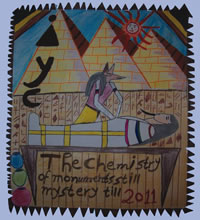 |
| Merihan Alaa (Egypt) |
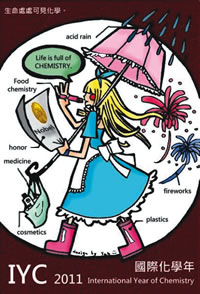 |
| Yeh Ying Chen, Taiwan |
Headed by Lida Schoen and Christiane Reiners of the IUPAC Committee on Chemistry Education (CCE), the competition was launched in Paris last January during the IYC 2011 opening ceremony at UNESCO Headquarters. “Chemistry as a Cultural Enterprise” was the theme of the competition; all entries were required to highlight the impact of chemistry on a country’s culture and everyday life. Designs were judged for their artistic value, how well they showed the relationship between chemistry and the national/regional culture, and the quality of the description (max. 50 words). The competition benefited greatly from social media: the site students used to upload their submissions allowed for sharing of comments and reviews. In so doing, the competition itself became a social and cultural enterprise. In fact, among the criteria used by the judges were the number of hits and number and quality of the peer reviews on the site.
Due to a generous gift of GlaxoSmithKline the winners received $500 and the runners up $250 (for the group). A selection of the best designs will be on display during the IYC Closing Ceremony in Brussels. Cyprus issued a customized stamp with the runner-up design and the National Dutch Postal Services did the same with the Dutch winners’ design.
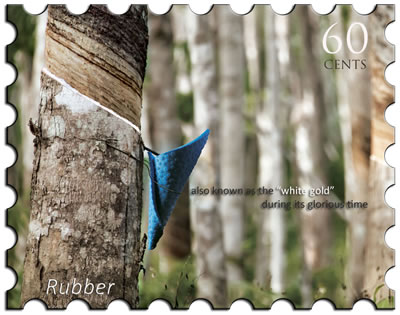 |
Winner 15-18: Muzhafar Hassan Ismail, Malaysia
“This is the remarkable icon of Malaysia. Rubber is actually a plant originated from Brazil, but it was brought to Asia by Singapore. Despite the limited land for plantations, it was then planted in Malaysia. Back then, it was “White Gold” that people were hunting for, instead of the black gold of today (the petroleum). Soon after its introduction, rubber plantations spread all over Malaysia. This valuable commodity was essential to the country’s growth. Today, maybe rubber is not regarded as the White Gold anymore, but its remarkable story lives on . . .” |
 |
Winner undergraduates: Peter Yuosef, Philippines
“My stamp is about the benefits of coconut and its contributions to science and industry. The coconut tree is considered to be the tree of life because of its many benefits to people and the environment. An important breakthrough in the field of medicine is the discovery that lauric acid, found in the coconut fruit, can fight the HIV virus. Bio-diesel from coconut trees is also another great discovery which could replace fossil fuels and help the environment.” |
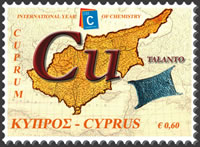 |
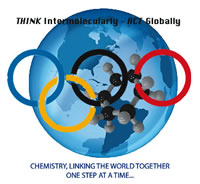 |
| Stavrou Maria (Cyprus), Runner-Up 15–18 |
Kyle Stratford (USA)
Runner-Up 15–18 |
The international jury consisted of Prof. Morton Hoffman (CCE NR USA, ACS), Dr. Rachel Mamlok-Naaman (CCE NR Israel), Dr. Lynn Hogue (ACS), Datuk Dr. Soon Ting Kueh (CCE NR Malaysia, IKM, FACS), Dr. Anthony Smith (EC2E2N), Dr. Harry Kelly (GlaxoSmithKline), and Prof. Daniel Rabinovich (USA, stamp expert).
This IYC activity enjoy the support of IUPAC, the American Chemical Society, GlaxoSmith Kline, The European Chemistry and Chemical Engineering Education Network, the Institut Kimia Malaysia (IKM), and Jeff Howson (E2BN.org).
www.chemistry2011.org/participate/activities/show?id=110
 |
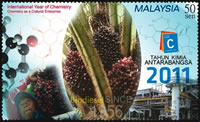 |
| Erica Lind, Paulina Ja¦êhde, Frida Richter, Erika Kankkunen (Sweden) |
Luqman Fauzi (Malaysia)
Runner-Up 15–18 |
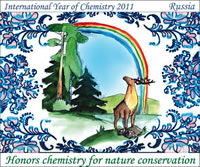 |
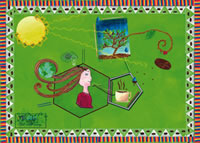 |
| Tatiana Tikhonova (Russia) |
Maria Pulido (Colombia) |
Page
last modified 17 November 2011.
Copyright © 2003-2011 International Union of Pure and Applied Chemistry.
Questions regarding the website, please contact [email protected] |